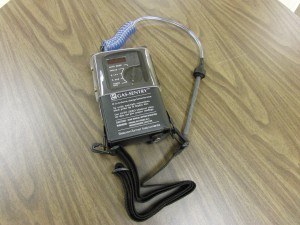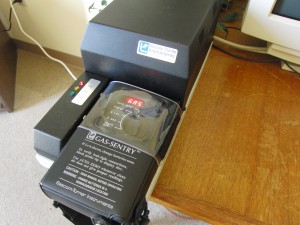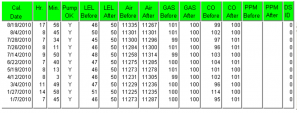January 2011 Vol. 238 No. 1
Features
What To Consider When Choosing A Gas Detector
PSE&G, with about 1.7 million gas customers in New Jersey, has a first responder program to ensure that technicians respond to a leak emergency call within 60 minutes or less1. To meet this goal, procedures are reviewed yearly, new service personnel receive extensive classroom and hands-on training, and apprentices are matched up with experienced technicians in a Field Experience Program for four months [1].
Reliable response to leak complaints relies not only on training but also on proper tools and instrumentation. PSE&G technicians typically use Bascom-Turner Gas Sentry (Model CGC-301) detectors to carry out leak and carbon monoxide investigations. These instruments have a catalytic sensor, a thermal conductivity sensor, and an electrochemical carbon monoxide sensor, and can be used for both natural gas and carbon monoxide investigations.
After the detectors passed PSE&G’s laboratory tests over the specified range of ambient conditions and concentrations of natural gas (0 to 100%) and carbon monoxide (0 to 2,000 ppm), 50 instruments were purchased by PSE&G and used in the field for approximately nine months to establish field reliability, ease of use, and general acceptance by field personnel. Based on this experience, the detectors were gradually introduced to all service personnel. Presently, the instruments have been in the field for eight to ten years with consistent and reliable performance and minimum maintenance.
PSE&G’s experience with instrumentation generally suggests that there are five key factors—accuracy, ruggedness, intuitive use, reliability and ease of calibration—to consider when choosing the right instruments for leak investigations.

Accuracy. The accuracy factor depends on sensor performance, and up-to-date electronics and operating software as well. These factors are inter-related and must work together to yield optimum results for the detector. In recent years, software has become a dominant factor in instrument design. Since all complex software will need to be updated from time to time, ease of software upgrades in the field, either by a simple change of microprocessors or by downloading through a digital interface, is an important criterion in selecting a detector.
Ruggedness. The major mechanical components of a detector are the case and the pump. A detector’s casing must be strong enough to withstand normal in-field wear-and-tear so the machine’s sensors and pump do not incur significant damage. The pump is an important sub-system whose proper function is crucial to the operation of the detector. A diaphragm pump is best for carbon monoxide investigations, but it must be engineered to protect its valves from dust and other debris encountered in the field. Filters and “water-block” attachments are effective in protecting the pump and the sensors from contamination in “dirty” environments, including those encountered in bar-holes.
Intuitive Use. While classroom and hands-on training for the proper use of gas detectors are important in the overall leak detection training, ease-of-use is an important attribute and should be given considerable weight in detector selection. Since these instruments are used in situations where safety is involved and decisions must often be made quickly, it is imperative that readings be unambiguous and not easily misinterpreted. As with any product, intuitive operation is important in gaining consumer acceptance, but with safety equipment, clear, easy operation is not only preferable, it is necessary. Instruments that are easy to use make personnel more comfortable and confident, and enable them to conduct a thorough leak investigation more quickly.

Reliability. One of the most important factors in selecting a detector is reliability. A detector that is constantly in the shop is not worth having. If repairs become necessary, a short repair time is important in minimizing costs and the spare inventory required to maintaining smooth field operations. Therefore, modularity of construction is important in maintaining and servicing detectors since this keeps both inventory of spare parts and out-of-service time to a minimum.
Ease Of Calibration. All detectors, no matter what technology they employ, require calibration from time to time. Calibration establishes whether an instrument functions properly, and whether its operation has remained sound. A properly calibrated instrument allows a consistent level of accuracy to be maintained and ensures that the designed performance has not been degraded.
Instruments with catalytic sensors lose sensitivity as the sensors are subjected to harsh environmental factors—from poisons to plain dirt. Typically, such instruments should be calibrated at intervals ranging from one to three months. A proper selection of the calibration interval depends on local experience and should be adjusted to reflect local factors. In the particular case of detectors utilizing a thermal conductivity sensor together with a catalytic element, safety is maximized if the thermal conductivity sensor is used to test for natural gas in the 5 to 15% range (the flammable range) and at higher concentrations (up to 100%).
A thermal conductivity sensor is largely unaffected by factors that tend to degrade catalytic sensor performance. Table 1 shows the gain—a measure of sensitivity of a thermal conductivity sensor—over a six year period of field use. It is apparent that after many years of field use, the sensor characteristics have remained fixed.

Table 1: Gain Constant of a Thermal Conductivity Sensor. The gain constant of a Bascom-Turner thermal conductivity sensor over six years of field service – the average deviation is 0.5%.
Instrument calibration is essential not only for assuring proper functioning of detectors but also for meeting regulatory requirements. A detector can, of course, be calibrated by a user as long as there is access to calibration gases; however, documentation of the required procedure is best achieved with computer-based systems, for example, Bascom-Turner’s N-CAL system employed by PSE&G. The advantages of a computer-based system are many-fold.
In addition to permanent record-keeping, they include diagnostics for preventive maintenance, management of detector field deployment, automatic generation of e-mails reminding users of calibration due or overdue, and a variety of other management reports ranging from histories of specific instruments to profiles of specific users. This information allows refinements in procedures and training to achieve higher efficiencies. An example of such reports is shown in Table 2.

Table 2: Calibration History by Unit ID Number.
When safety is involved, it is important to not only have highly trained professionals, but to have the right equipment to do the job. PSE&G’s experience shows that properly selected detectors managed with a computer-based system can provide many years of cost-effective service.
Authors
Paul Pirro serves as technical support leader-gas delivery for Public Service Electric & Gas Company (PSE&G). He supports development of technical and operational procedures, technical training, emergency response, gas detection instruments, new tools, appliance parts identification and distribution synergies. He has 29 years of experience in the utility industry. He is a former chairman of the AGA Utility & Customer Field Services Committee and is presently Chairman of the Northeast Gas Association – Customer Utilization Committee. He received the AGA’s Milton Heath, Sr. Award (1996) for contributions made to promote the advancement of leak detection technology, and the Acker Medal (2000) for top industry paper of the year covering carbon monoxide emergency response and prevention.
George S. Champey is the national sales manager of Bascom-Turner Instruments and has been with the company since 1979. He is a member of both the AGA and the New England Gas Association Customer Service Committees and has been a guest speaker at various roundtables and seminars in the natural gas industry nationwide.
References
1. P. Pirro “Leak Response Emphasized at PSE&G,” Pipeline and Gas Journal, 234, No. 2, Feb 2007.





Comments